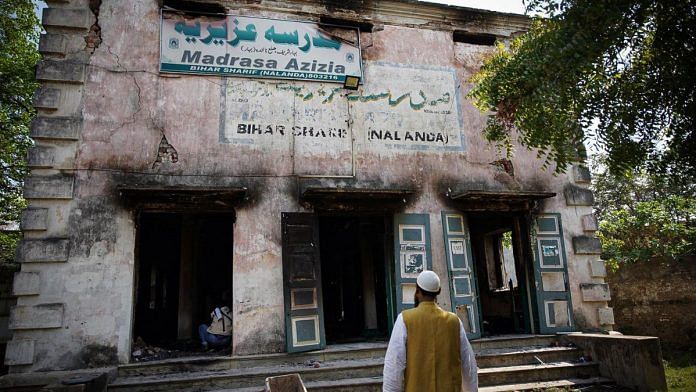Amid the upheaval in Bihar Sharif during Ram Navami processions, images of the gutted 110-year-old religious and educational heritage site, Madarsa Azizia shook the Muslim community across India and beyond. The madrasa was targeted and torched by extremists on 31 March. The historic library within its precinct housed an estimated 4,500 books of Islamic literature with some rare manuscripts. The financial damage is upwards of Rs 10 crore, according to an initial estimate by conservation architect Ruknuddin Mirza. The community might take years to recover from the emotional and psychological damage that it caused. However, what has been more surprising is that the state, political elites and heritage practitioners have chosen to stay silent about the burning of the madrasa and the loss of cultural heritage. This has further aggravated the community’s suffering — they’re not just grappling with the loss of a century-old legacy but also a sense of alienation in their own homeland.
Also Read: What lies at the heart of Ram Navami violence? Indian labels like ‘Muslim areas’
Rich legacy
Established in 1896 and later shifted in 1910 to a sprawling three-acre campus in Bihar Sharif, a historic city in the Nalanda district of Bihar, Madrasa Azizia was built by the philanthropist Bibi Soghra in memory of her husband, Abdul Aziz. Soghra inherited property worth lakhs after her husband’s death and decided to donate it to the waqf. A large chunk of this donation was envisaged to be spent on the health and education of marginalised Muslims in Bihar.
The madrasa is one of the very first educational establishments built by Bibi Soghra’s donations. Others include Soghra High School and Soghra College. They are still managed by Soghra Waqf Estate. Since its inception, Madrasa Azizia has been a well-known hub of Islamic education having hostel facilities for students, as well as teachers and a mosque within its precinct. As per the latest reports, 300 students study at the madrasa, ranging from those in class one to those pursuing postgraduate courses.
Based on its continued efforts to improve the education of Muslim communities in Bihar, the Madarsa received recognition from the British government in 1920. Later on when the efforts for Indian independence were at their zenith, a number of Muslims who studied at the Madarsa participated in the struggle for freedom from the British. In March 2020, the madrasa received a special mention from the United Nations Population Fund (UNFPA). The team was in the state as part of a visit to interact with students under an educational programme run by the Bihar State Madrasa Education Board.
The madrasa is a symbol of a sense of belonging, shared identity, memories and peaceful co-existence for Muslims in Bihar and beyond.
This is not the first time the madrasa has been targeted, there have been attempted attacks on it during the 1981 riots and later in 2017.
Also Read: Ram Navami violence in Ramzan month shows future is stark. It’s ‘karo ya maro’ for India now
Destruction of cultural heritage
The intentional targeting of heritage sites is not unique or new. Cultural heritage, specifically religious and syncretic heritage which are symbols of peaceful co-existence and social cohesion, has been targeted since time immemorial. Be it the burning of synagogues in Hitler’s Germany or vandalism of mosques and churches alike during the Bosnian war in the former Yugoslavia, the alleged torching of Charar-e-Sharief in Kashmir during the active phase of Kashmir Insurgency in 1995 or the desecration of the ancient library of Timbuktu by Ahmad Al-Mahdi in 2013. These incidents of deliberate destruction and the torching of the Madarsa Azizia are part of a pattern to incite fear, intimidation and humiliation and cause psychological harm to the affected communities.
Scholars have highlighted that the fear, humiliation and intimidation such acts incite impact the everyday life of affected communities. Polish lawyer Raphael Lemkin historically labelled the deliberate destruction of cultural heritage as ‘cultural genocide’, highlighting the relationship between human security and heritage destruction.
With the advent of urbanisation, the blurring of civilian and non-civilian boundaries during contemporary conflicts has rendered cities and built heritage at higher risk of deliberate destruction. Ostensibly, human security has been inferred as inseparable from the protection of built heritage in the events of conflicts.
The state’s decision to intervene to prevent such attacks on cultural heritage or its failure to do so influences the trust of affected communities in the state and therefore its legitimacy. In cases like the Timbuktu Library torching, the Mostar bridge destruction or the destruction of Palmyra’s arch efforts were made to reconstruct the historic fabric of these heritage sites in an attempt to restore peace and harmony.
However, the on-ground response to the intentional targeting of Madarsa Azizia is highly siloed. It is irresponsible and surprisingly frustrating that the incident has not been publicly condemned by the state, the political elites or even the heritage practitioners. While an online initiative launched by the community to restore the gutted Madarsa is already in place, state intervention to restore the desecrated heritage is the way forward to restore peace, cohesion and trust. It is crucial that the state, the political elites and the heritage practitioners form a coalition to retrofit, reconstruct and restore the damaged heritage.
Sabine Ameer is an architect-urban planner whose primary research explores the interlinkages between urban heritage, human security and legitimacy. She tweets @Sabineameer. Views are personal.
(Edited by Theres Sudeep)



